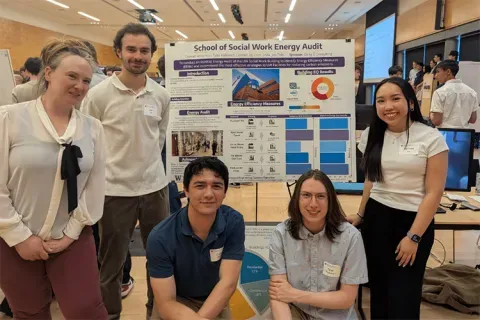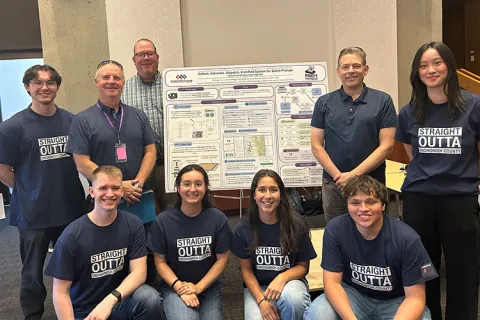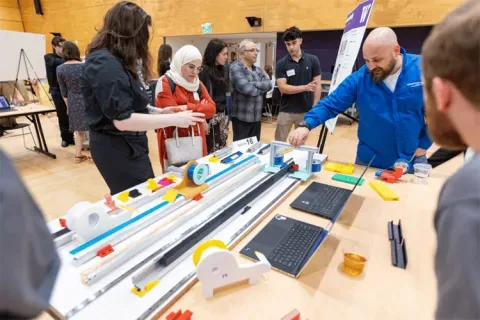Industry-Sponsored Student Capstone Projects
2022/2023
In the 2022/23 academic year the industry capstone program was supported by 56 sponsors and 99 real-world projects. Nearly five hundred and fifty students from across the College of Engineering participated. Scroll down to learn more about each project.RadiusAI
Photo-Realistic Synthetic Image Generation
Radius AI is on the forefront of AI-driven retail and healthcare computer vision-driven systems. As part of our retail expansion at the time of this project, Radius AI was categorizing an ever-expanding list of consumer products. For this project, this student team set out to investigate, research, and develop state-of-the art methods for photo-realistic synthetic image generation. This student team also worked to propose solutions ranging from AI/GAN based approaches to 3D reconstruction, implement object detection and recognition, and demonstrate any resulting improvements. Desired outcomes and deliverables this student team worked towards included creating a proven methodology that may be used to scale-ably create diverse training scenes. This student team worked to: a) Deliver a report or presentation discussing all methodologies that were attempted b) Deliver the resulting codebase in the form of a github that may be utilized by RadiusAI
Sagetech Avionics
Bluetooth Converter Module with Integrated GPS
Sagetech Avionics designs micro transponders and collision avoidance systems for use in primarily UAS but are also relevant to crewed aircraft. Their products provide data out via RS232 using a custom protocol. In order to interface with applications that will display their data, this student team worked to design equipment that will convert the display data to GDL-90 protocol and send it via bluetooth to a IOS and Android application. Sagetech provided most of the hardware design that students will work to tweak and send out to Fab. Most of the work was to be software. This student team worked to develop the following application features: Powered by 5V Converts 232 ADS-B in report data to GDL-90 to be displayed on Foreflight Custom Sagetech Application to program Sagetech devices IOS and Android Applications Provides GPS data out Anticipated outcomes of this project included: FPS - Functional Product Spec SRS - System Requirement Spec Requirements Trace matrix that allocates high level (SRS) requirements to specific low level functions (HW, SW, Mechanical) Low level requirements docs Test plans to cover all requirements documents Prototype hardware that can be used on multiple UAS to be tracked on a common display application on a smart phone/tablet.
Seattle City Light
Design a Building Electrification Demonstration Vehicle
Based on project concept input from Seattle City Light, this student team worked to create detailed design drawings and engineering for a mobile building electrification demonstration vehicle. (The scope did not include engineering of the vehicle itself, just the demonstrations on it and modifications to accommodate the demonstrations.) This student team also worked to develop a user dashboard to display system(s) data as well as interpretative text and graphics for users. The student team aimed to show technology applications that could be used in buildings, not in motor coaches, or motor homes. Anticipated outcomes this student team worked toward included: - A set of detailed drawings and images that could be turned over to a contractor to begin fabrication of this vehicle demonstration. These would include real world products such as: the heat pumps, micro-grid, battery storage, water storage, plumbing, electrical, a controls dashboard, and a vehicle that could be modified to house all of this working equipment. - Cost estimates should be provided for each component as well as a general installation costs for the entire vehicle. - A short presentation to a select group at Seattle City Light. - Graphics and text for the displays would be a bonus.

T-Mobile
Augmented Reality Cell Site Visualization App
Reliable, high-speed internet access is becoming a necessity. However, customers lack choice and freedom with their current internet service providers and existing cable infrastructure. Wireless home internet is a growing use-case for 5G, but customers experience service issues due to suboptimal indoor home internet device placement. Compared to indoor devices, outdoor device placement offers better RF conditions. Outdoor installation also enables the use of high band mmWave frequencies due to line-of-sight requirements. Optimal outdoor installation is challenging and often requires professional installation. This student team worked to develop an augmented reality app to assist T-Mobile wireless home internet customers with indoor/outdoor device placement, give T-Mobile customers a tool to visualize the nearest cell site and antenna configuration, recommend device placement with highest predicted line of-sight to ensure an optimal home internet experience, and assist with outdoor home internet device installation challenges otherwise requiring professional help. Anticipated outcomes this student team worked towards included: - Investigation and analysis of antenna parameters and RF conditions - Understanding of wireless network architecture and RF conditions. - Trained ML model to predict RF conditions of device placement - Machine learning model training, evaluation, and deployment - Proof-of-concept augmented reality mobile app for home internet device placement - Inclusive UI/UX app design and test-driven, collaborative app development
Turion Space
Spacecraft Rendezvous Attachment Mechanism Testing Apparatus
This student team sought to develop and produce the initial build of a testing apparatus for space-rated attachments mechanisms purposed for Active Debris Removal (ADR) and On-orbit Service and Manufacture (OSAM) operations. The primary purpose of this system was to quantify the performance of a variety of adhesives and mechanical attachment mechanism designs in thermal vacuum (TVAC) chambers replicating a space-like environment. Specific qualities Turion seeks in this testing apparatus include a variety of surfaces, ability to test adhesion at various approach angles, and measure mechanical forces imposed on the surface in multiple directions as well as the attachment mechanism. The student team worked to rate the system to survive 10^-6 torr and temperature ranges between –40C and + 80C and to be controlled and powered via feedthroughs on standard TVAC chambers. While testing the apparatus design and the initial build were expectations Turion Space has of this student team, Turion also wanted to see the student team work to accomplish testing the apparatus.

UW Medical Center
FPGA System for RF Power Supply Control
One of the main subsystems of the cyclotron is the RF system that is responsible for generating and regulating the RF waves that create the electric field in which the particles are accelerated. One part of the RF system, the RF power supply control (RPSC), handles command, status, and interlock signals for the many power supplies in the RF system as well as their integration into the larger cyclotron control and IO system. The RPSC is still largely original components and older style of digital logic: lots of circuit cards with bulky logic gate chips and flip-flop circuits that interface with the IO system to communicate system status and if the RF system is ready to turn the beam on. For this project, the student team worked to take all those RPSC logic circuits and replace them with an FPGA based system. A modern FPGA can easily handle the various logic circuits that govern the RPSC signals. The project had two phases: first to work to identify the best FPGA platform for this project, and second to attempt to convert all the existing digital logic circuit cards into FPGA code that will run on the selected device. The redesign with an FPGA this student team worked towards aimed to clean up the RF system complexity and provide a basis to convert more of the RF system over to an FPGA system in the future. Anticipated outcomes this student team worked towards included: - A documented state-of-the-art review on FPGA platforms along with a final recommendation on which to use for this implementation and why. - Logic maps for the signals in the RPSC that represent the programming in the FPGA for future troubleshooting needs. - Full set of circuit diagrams, schematics, signal list, and written documentation of the system designed. (if applicable) - Programmed and tested FPGA system in a 19" rack that can replace the currently 18 logic circuit cards of the RPSC.
Related News

Mon, 10/13/2025 | UW Mechanical Engineering
Capstone collaboration leads to award
An ME capstone team received first place for its energy audit of the UW School of Social Work building.

Thu, 07/17/2025
UW engineering students develop smart ballot solution
UW engineering students develop smart technology solution to improve ballot collection for Snohomish County.

Mon, 07/07/2025 | UW Mechanical Engineering
Capstone creations
Students displayed innovative capstone design projects at the 2025 expo.

Fri, 09/20/2024 | UW Civil & Environmental Engineering
Smarter irrigation for a greener UW
A new project combines satellite data with ground sensors to conserve water and create a more sustainable campus environment.